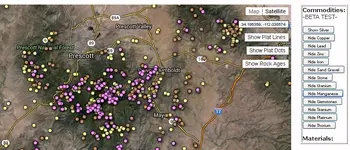Desertphile
Full Member
I have finally taken the time to update my MRDS / Google Maps web site so that it is more friendly to users, and also so that the maps can handle the 84,400+ records in the MRDS that include "gold" in their entries. I have also added a database for the absolute ages of rock samples for the USA.
The front page is here: Free Gold Maps
The user's interface is here: Free Gold Maps; New user interface
There are currently three report options for the updated user's interface: brief data grid, detailed data grid, and Google map layer. Selection is done by Country, State (or equivalent), and County (or equivalent).
The "Map by geocode location" page is here: Free Gold Maps; Gold record map via town and state.
Most people I suppose will find the address service (Map by geocode location) to meet their needs.
Note that there are web sites that charge money for this information, anywhere from $1 a day for a subscription, to $47 for "reports" with this information. That annoyed me, since the databases are in the public domain, and freely available on-line.
In a few days I am going to the desert to work one of my placer claims for around 30 days, and when I return I will be adding other databases for minerals other than gold.
The front page is here: Free Gold Maps
The user's interface is here: Free Gold Maps; New user interface
There are currently three report options for the updated user's interface: brief data grid, detailed data grid, and Google map layer. Selection is done by Country, State (or equivalent), and County (or equivalent).
The "Map by geocode location" page is here: Free Gold Maps; Gold record map via town and state.
Most people I suppose will find the address service (Map by geocode location) to meet their needs.
Note that there are web sites that charge money for this information, anywhere from $1 a day for a subscription, to $47 for "reports" with this information. That annoyed me, since the databases are in the public domain, and freely available on-line.
In a few days I am going to the desert to work one of my placer claims for around 30 days, and when I return I will be adding other databases for minerals other than gold.
Upvote
0






